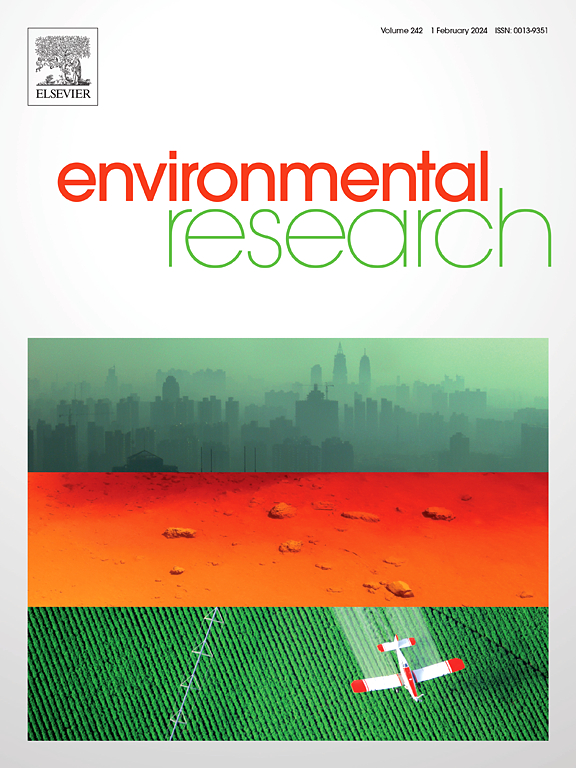水流之外:地中海间歇河流硅藻群落的生态学见解
IF 7.7
2区 环境科学与生态学
Q1 ENVIRONMENTAL SCIENCES
引用次数: 0
摘要
间歇河(IR)是全球分布最广的水道之一,其特点是干湿交替。尽管存在这些波动,但红外光谱支持着多样化的生态系统和相当大的生物多样性。在这些河流中发现的生物群落中,硅藻是关键的初级生产者和生物指标。由于对干旱如何影响IR生物多样性的认识有限,本研究调查了硅藻对季节水文变化和水流的响应。具体来说,它侧重于在自然发生的地中海IR硅藻的分类和功能组成和群落结构。总体而言,物种丰富度似乎不受干旱和水流的影响,在湿地和湿地的观测值相似。分类和功能α-多样性普遍较高(TRic = 12.9;ric = 9.79);frc = 3.23),但α-多样性在不同位点间无显著差异。虽然环境变量对α-多样性的影响不显著,但排列分析发现温度(F = 1.49, p = 0.09)和溶解氧(F = 2.11, p = 0.01)是分类和功能α-多样性的重要预测因子。然而,季节性对分类学(F = 2.28, p = 0.009)和功能性(F = 8.86, p <;0.01) β-多样性,8月变异较大(1.33倍)。研究结果还表明,不同位点类型间的分类分散性存在显著差异(F = 2.21, p = 0.04),但功能分散性无显著差异。这些结果表明,尽管IR条件可能并不一定影响硅藻α-多样性,但季节变化对群落更替起关键作用,突出了水期对IR生物多样性形成的重要性。在持续的气候变化背景下,这些发现尤其相关,因为水文制度的变化可能越来越多地影响红外系统的生态动态和群落结构。本文章由计算机程序翻译,如有差异,请以英文原文为准。

Beyond the flow: ecological insights from diatom communities of a Mediterranean intermittent river
Intermittent rivers (IR) are among the most widespread watercourses globally, characterized by alternating dry and wet phases. Despite these fluctuations, IRs support diverse ecosystems and considerable biodiversity. Among their biotic communities found in these rivers, diatoms serve as key primary producers and bioindicators. Due to the limited knowledge of how droughts affect IR biodiversity, this study investigates diatom responses to seasonal hydrological changes and water flow. Specifically, it focuses on taxonomic and functional composition and community structure of diatoms in a naturally occurring Mediterranean IR. Overall, species richness appeared to be unaffected by droughts and water flow, with similar values observed at both lentic and lotic sites. Taxonomic and functional α-diversity were generally higher in lotic waters (TRic = 12.9; Fric = 9.79) compared to lentic (TRic = 8.7; Fric = 3.23) sites across all diversity indices, though no significant differences were found in α-diversity between sites. While the environmental variables considered did not significantly affect variability between sampling sites, permutational analysis identified temperature (F = 1.49, p = 0.09) and dissolved oxygen (F = 2.11, p = 0.01) as important predictors for taxonomic and functional α-diversity. However, seasonality significantly influenced taxonomic (F = 2.28, p = 0.009) and functional (F = 8.86, p < 0.01) β-diversity, with greater variability (1.33 times) observed in August. Findings also indicate significant differences in taxonomic dispersion between site types (F = 2.21, p = 0.04) but no significant differences in functional dispersion. These results suggest that whereas IR conditions may not definitely influence diatom α-diversity, seasonal changes play a key role for community turnover, highlighting the importance of the hydroperiod for shaping IR biodiversity. In the context of ongoing climate change, these findings are particularly relevant, as shifts in hydrological regimes may increasingly affect ecological dynamics and community structure in IR systems.
求助全文
通过发布文献求助,成功后即可免费获取论文全文。
去求助
来源期刊

Environmental Research
环境科学-公共卫生、环境卫生与职业卫生
CiteScore
12.60
自引率
8.40%
发文量
2480
审稿时长
4.7 months
期刊介绍:
The Environmental Research journal presents a broad range of interdisciplinary research, focused on addressing worldwide environmental concerns and featuring innovative findings. Our publication strives to explore relevant anthropogenic issues across various environmental sectors, showcasing practical applications in real-life settings.
 求助内容:
求助内容: 应助结果提醒方式:
应助结果提醒方式:


